When you visit Hawaii, you need to be mindful of the sun and protect yourself to avoid a serious sunburn. Choosing a good sunscreen will go a long way to keep you and your family safe, but you need to be careful which sunscreen you choose.
Hawaii is surrounded on all sides by ecosystems that can be harmed by the chemicals found in certain sunscreens and those should be avoided. There are many options to choose from that are reef-safe and Hawaii-approved, and we’ve included reviews of several after the FAQ.
You’ll be a part of the solution by making wise and informed decisions about sunscreen, which goes a long way to help preserve some of the most beautiful habitats in the United States.
Before we get into the best reef-safe sunscreen for Hawaii, let’s address some of the most common questions about sunscreens.
Hawaii Sunscreen FAQ
Should you wear sunscreen in Hawaii?
You should definitely wear sunscreen during a visit to Hawaii. As one of the most southern locations in the United States, you’re as close as the country gets to the equator. The sun is often completely unobscured and directly overhead during the day. Of course, this is one of the major attractions of Hawaii, but it’s a kind of sunlight travelers need to be prepared for.
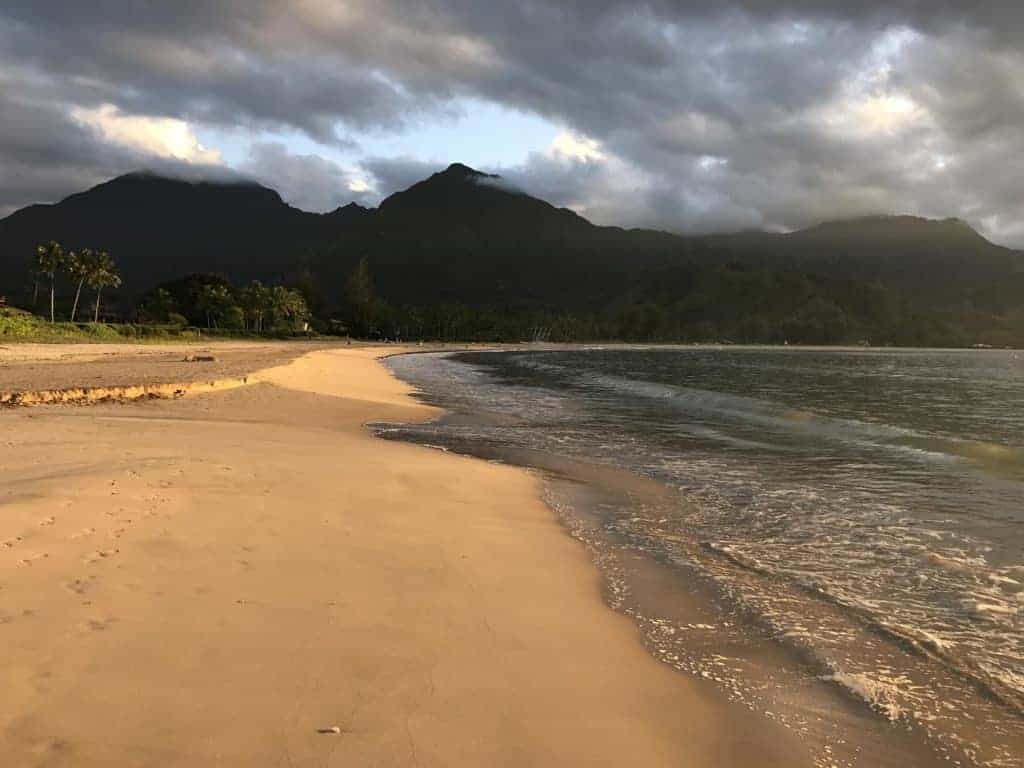
As we’ll cover in a later question, consider sunscreen just one of the points in an overall plan to protect yourself from the strong UV rays you’ll experience here. The key to a happy, sunburn-free trip to the Aloha State is to be mindful of the sun at all times.
Since you will more than likely be spending a lot of time out on beaches like Poipu Beach or hikes, wearing sunscreen is a must. Even more importantly, you should wear Hawaii reef-safe sunscreen when swimming or snorkeling at the beaches to protect the local environment and marine life.
If you want to achieve that golden, glowing tan of the folks who call Hawaii home, sunscreen is a great way to gently do it and keep you protected at the same time.
Which sunscreens should you avoid?
To comply with Hawaii sunscreen laws, avoid any sunscreen that contains octinoxate, oxybenzone, mineral oil, or titanium dioxide. These chemicals have been directly linked to coral bleaching and eventual degradation of coral reefs worldwide.
You can read our up-to-date list down below of the best sunscreens that are Act 104 compliant. Take advantage of this wealth of information and choose a sunscreen that complies with the act.
Some of the biggest names in sunscreen have been known to sell products full of banned chemicals, but they are starting to come around. Most have since created Hawaii-approved products.
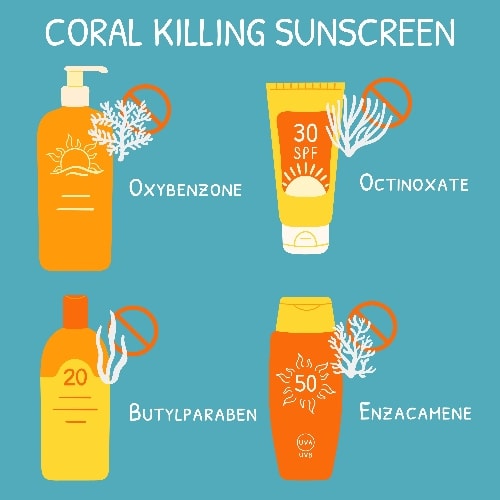
The trend toward reef-safe alternatives for worldwide acceptance is promising, and it won’t be long before the banned chemicals are completely out of circulation.
For travelers with sensitive skin, be on the lookout for brands that tout the natural content of their products. The higher the number the better, and the more ingredients both active and inactive, the better. Your skin is important, and you need to take care of it when exposed to the intense sunlight on all the islands of Hawaii.
Avoid buying any sunscreen that is less than SPF 15 and greater than SPF 90. You’ll find that SPF 15 is not sufficient protection for the Hawaiian sun, and anything over SPF 90 is simply not necessary.
What are the laws about sunscreen in Hawaii?
Hawaii has taken measures above and beyond any other state to protect its environment and the surrounding waters. Through Hawaii Reef Act 104, the Aloha State has taken a crucial step in protecting marine life by limiting what sunscreens may be used on the islands.
As of January 1, 2021, the act bars the use of sunscreens that contain octinoxate and oxybenzone, the two main culprits in the degradation of coral reefs. It should be noted that many of the major, brand-name sunscreens still use these chemicals. Buyer beware and make sure to check the label of your sunscreen to make sure you don’t have any of the offending chemicals.
These laws are the first of their kind and are intended to protect some of Hawaii’s most cherished assets. You also benefit from this law by having a safer product that you can count on to protect your own self.
If you already have a sunscreen product that isn’t Hawaii-approved, many retailers will allow you to trade them in for a discount or swap for one of the approved products. Hawaii wants what is best for the land they call home, the people who live there, and the visitors who come to witness the awe-inspiring beauty of the islands.
Other locations have followed suit or created similar laws. These locations include other islands with habitats worth protecting, such as the U.S. Virgin Islands and Aruba.
What remains unclear is how effectively this law can be enforced with the sheer number of visitors to Hawaii every year. A little public awareness goes a long way, though, and the state’s government and the Bureau of Tourism do very well to spread the information far and wide.
The law primarily affected retailers in Hawaii and ensured that products with the banned substances would no longer be sold anywhere on the island. This leaves it up to visitors like yourself to be responsible and refrain from introducing the banned chemicals to the environment.
Tips About Buying Sunscreen In Hawaii
The best thing to do in order to stay compliant with the law and protect everyone and everything at risk is to pick up your sunscreen when you land in Hawaii or buy one online that you know for sure is reef-safe. This has the added benefit of supporting the local economy, which is heavily influenced by the amount of tourism dollars spent.
Most visitors will probably just need to worry about bringing one bottle. If you plan to stay for a week or two, you should be okay with just one. But if you’re planning to stay longer or up to a month, you will definitely want two.
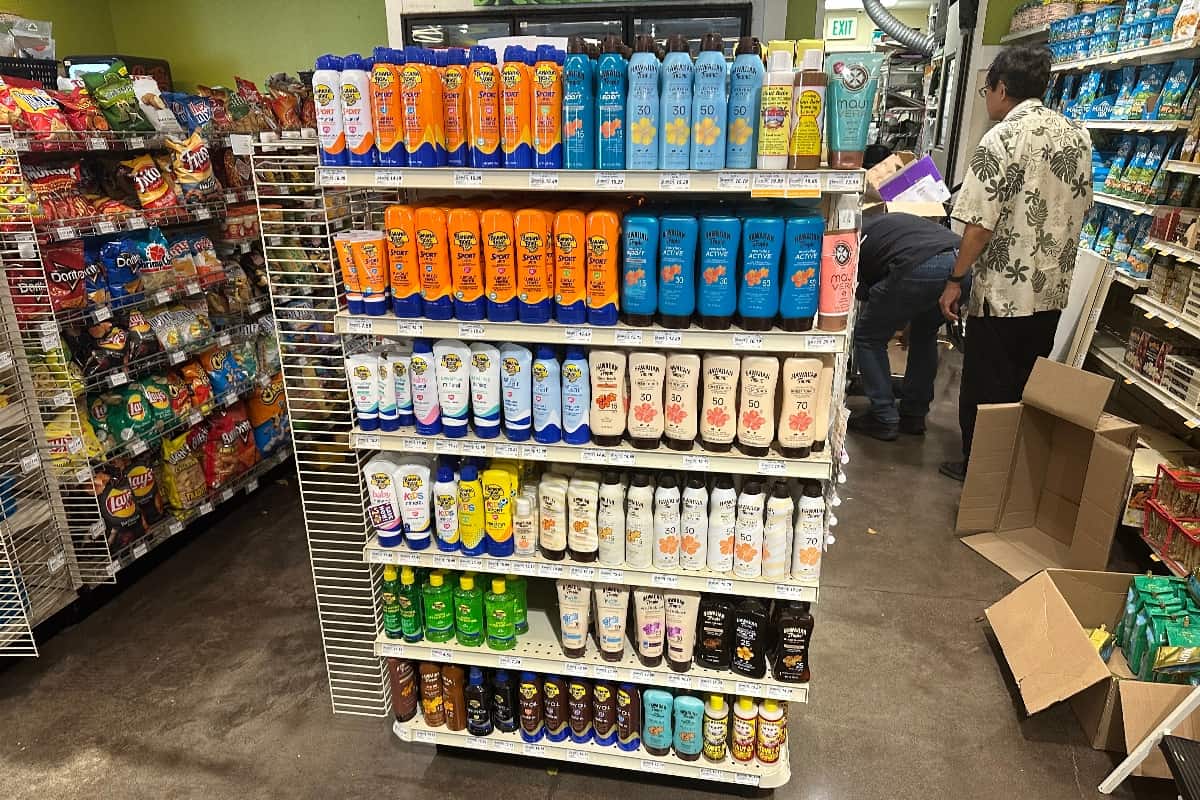
When choosing a sunscreen, it’s wise to aim higher than SPF 30. Consider picking up something SPF 50 or over, but know that anything above 70 is likely overkill and you’re paying for marketing. We use SPF 70, and it works fantastic for us. We try to apply it more than once if we’re spending more than two hours outside, whether that’s on a non-shaded hike or on the beach.
There isn’t much of a performance gain between 30, 50, and 70, so the step up to 90 or 100 isn’t worth any extra cost. Likewise, you shouldn’t spend your money on sunscreen under SPF 30, and anything under SPF 15 is inadequate protection for Hawaii. Trust us when we say that the sun in Hawaii hits a lot harder than in other parts of the United States.
You’ll find that there are dozens of brands of Hawaii-approved sunscreens to choose from, but some of the local favorites include Kokua Sun Care, Mama Kuleana, and Raw Love. All of these brands bear the label Made in Hawaii and provide eco-conscious protection of SPF 30 and over. The good people of Hawaii, the coral reefs, and your skin will all thank you if you choose an approved brand and product.
The general advice about sunscreen is that you should reapply every two hours or so, but use your best judgment. If you’ve been enjoying your time in the water and drying off, you may need to apply more often. Growing up, we were always told to apply sunscreen at least 15 minutes before getting wet to let it all soak in.
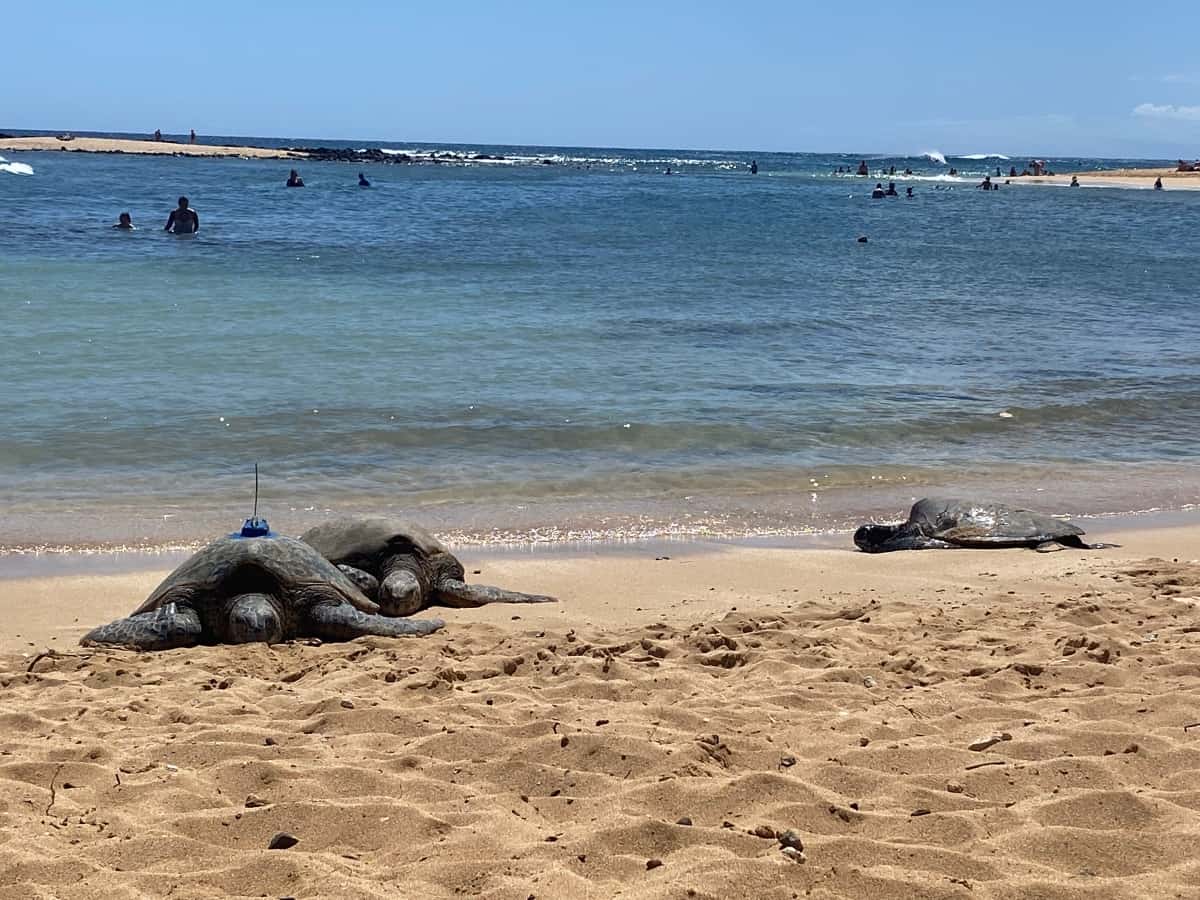
Hawaii is incredible, and you’ll want to see and do as much as possible during your time there, so do yourself a favor and apply sunscreen liberally. A sunburn can put a real damper on your time in paradise, and it’s completely avoidable. Put on more than what you may think you need.
Keeping children safe from sunburn can be a full-time job during your vacation, but it makes for a much better trip for all involved if you take it seriously. Set reminders for yourself and stay on top of reapplying when necessary.
You can ensure safety by being mindful of when you are exposed to the sun and avoiding time outside between 12:00 p.m. and 3:00 p.m. This is when the sun is at its highest point in Hawaii, and you’ll feel it barreling down on you. Since it’s not always easy to avoid those times, be mindful about putting on more sunscreen during this period.
Even when the sun is obscured by clouds, you’re still getting hit with loads of UV rays. It’s important that you stay vigilant because a sunburn can sneak up on you if you feel as though you are safe because of the shade.
Be careful how much time you spend on or in the water or near the sand, as these conditions all reflect sunlight and increase the likelihood that you’ll get a sunburn. It won’t do any harm to err to the side of caution and reapply in as little as an hour between coats.
In addition to timing, consider wearing a wide-brim hat for optimal UV protection of your head, neck, and shoulders. If you can spend some time shaded by a tree or umbrella during peak sunlight, it can be an effective way to lower the risk of sunburn. Some hikes, like the Maha’ulepu Heritage Trail, have very little to no shade, so wearing a head covering is a top priority.

Utilize the surroundings at your disposal and prepare for any change in scenery by keeping protective clothing on hand. Sunglasses are another important layer of protection that should be included in your Hawaii packing list.
Make sure to get polarized lenses that provide 100% protection from all forms of UV light. It’s a great way to look great and keep your eyes safe, like sunscreen does for the rest of your body.
Disclaimer: As an Amazon Associate we earn from qualifying purchases.
Best Reefsafe Sunscreens For Hawaii
Sun Bum Original

Sun Bum Original specifically complies with the Hawaii 104 Reef Act. It contains zero octinoxate or oxybenzone and provides serious SPF 70 protection. This is one of the highest-rated and most reviewed water-resistant sunscreens on the list and a fool-proof choice for the safety of everyone who wears it and of course the marine life around Hawaii.
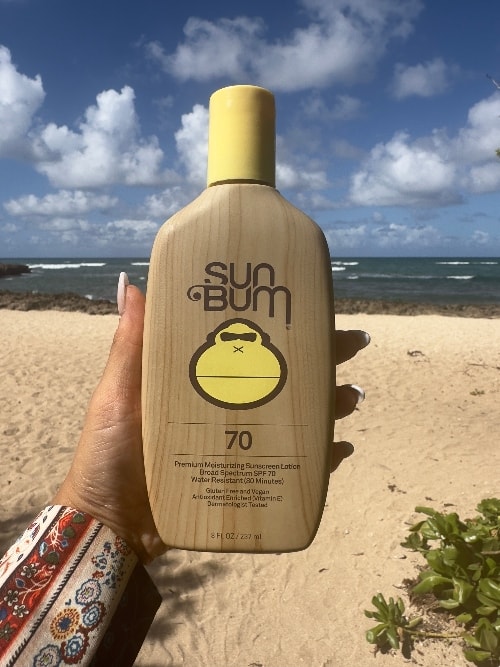
Be sure to apply Sun Bum Original once every two hours you plan to spend in the sun for optimal results. This advice applies to most sunscreens, but this is Sun Bum’s recommendation per the label. Better safe than sunburned. Sun Bum is what we use when we visit the beaches in Kauai and Oahu and we like that it doesn’t have a strong chemical smell.
Hawaiian Tropic Every Day Active

Hawaiian Tropic is one of the biggest names in sunscreen products, and they have created a few products that comply with Hawaii Reef Act 104. Every Day Active is one such product, and it contains no octinoxate, oxybenzone, or titanium dioxide.
It’s SPF 50, so you will be good to go without needing to apply it again for a couple of hours. Hawaiian Tropic Every Day Active was formulated with the end user and the planet in mind, and it’s PETA-certified cruelty-free.
You’ll love the continuous, clear spray that protects against UVA and UVB rays for up to 80 minutes.
Kokua Sun Care

Kokua Sun Care is a Reef Act 104-compliant sunscreen made right in Hawaii and sits on the state’s list of approved products. The primary active ingredient in Kokua Skin Care’s sunscreen is the mineral zinc oxide.
The SPF 50 formula will protect everyone in the family including the children for 80 minutes. The container is travel-friendly and TSA-approved weighing in at only 3 ounces. The combination of inactive ingredients such as kukui, macadamia, spirulina, and plumeria makes this sunscreen smell and feel like island time.
The brand gets its name from Kokua, meaning a selfless desire to help others, and this is apparent from its products. If you run out, you can also find this Hawaii sunscreen on the shelves of many of the island’s ABC stores.
Reef Repair

Reef Repair sunscreen is a non-nano zinc oxide mineral sunscreen. It is octinoxate, oxybenzone, and completely chemical-free, making it a great choice.
Bonus ingredients in Reef Repair have the added benefit of moisturizing and protecting skin of all types. Thanks to Reef Repair’s water-resistant natural formula, you’ll enjoy 80 minutes of protection in the sun, sand, and surf.
The super-clear, non-sticky formula makes application and reapplication a breeze. Apply every two hours for the best results but use your judgment if you’re enjoying time in the water.
Alba Botanica Hawaiian Sunscreen

Alba Botanica Hawaiian Sunscreen comes in SPF 30 and 45 with aloe vera and green tea fragrances respectively. They utilize a non-toxic formula that is free of the chemicals banned by Hawaii law.
Like most options, this reef-friendly sunscreen offers up to an hour and 20 minutes of reliable protection from UVA and UVB sunlight. All of this is from a product that is 100% vegetarian, Leaping Bunny certified cruelty-free, and from a company that has been protecting folks from the sun since 1979.
Be sure to check out Alba Botanica’s full range of sun care products, including sprays, lotions, and mineral sunscreens, as well as their after-sun products.
Mustela Mineral Sunscreen

Mustela is a French family-owned business that has been helping to protect travelers from the harmful effects of the sun since 1950. Their mineral sunscreen is a zinc-oxide product with 93% natural ingredients and zero banned chemicals as recognized by the Hawaii Reef Act 104.
Mustela’s commitment to the safety and well-being of your family extends to the environment with its pledge to be carbon neutral by 2030. They are also a Certified B Corporation, with an emphasis on being one of the best companies for the world, not just one of the best in the world.
Coral Isles Reef Safe

If you’re looking for a no-nonsense SPF 50 sunscreen that is Hawaii-compliant, Coral Isles Reef Friendly sunscreen is an excellent product at an affordable price point.
Every application gets you 80 minutes of broad spectrum, UVA, and UVB protection with a non-greasy, fragrance-free formula. The reef safe sunscreen is hypoallergenic and light, so it won’t bog you down and it’s water resistant so you can enjoy your time and dive right in.
In order to maximize the effectiveness of Coral Isles Reef Friendly sunscreen, reapply every couple of hours as needed.

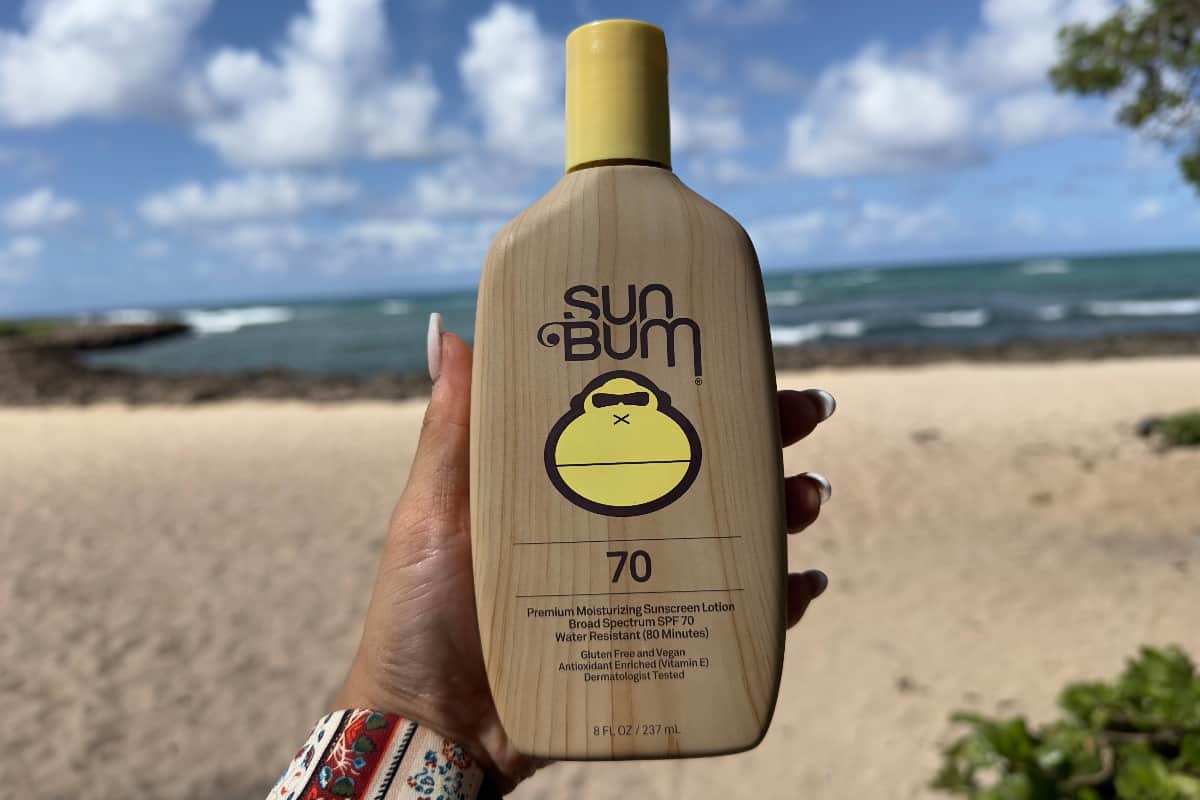
Leave a comment